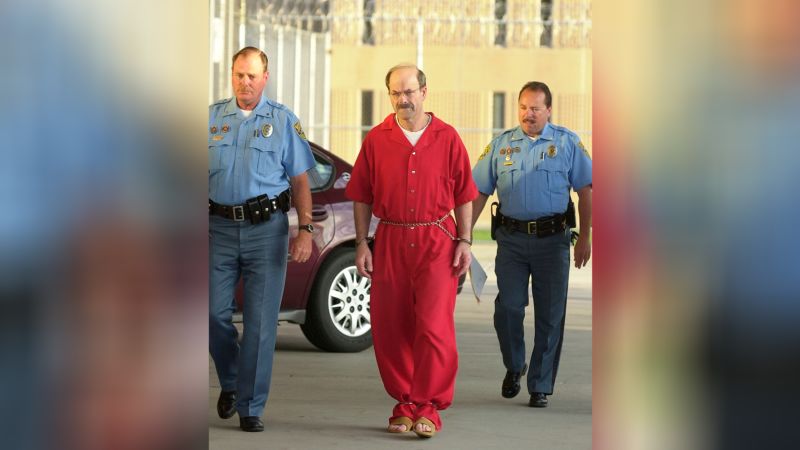CNN
—
Investigators searched a former residential property of Dennis Rader, the self-proclaimed BTK serial killer, in Kansas this week primarily in connection with a probe into the 1976 disappearance of an Oklahoma teenager, authorities said Wednesday.
Authorities also are checking whether Rader, who pleaded guilty in 2005 to murdering 10 people from the 1970s to the 1990s, is connected to “other missing persons cases and unsolved murders in the Kansas and Missouri areas,” the Osage County Sheriff’s Office in Oklahoma said in a news release.
Rader, who is serving life terms in prison, admitted in 2005 to carrying out the 10 brutal killings to fulfill his sexual fantasies. He suggested in a letter found long before his capture that he should be called “BTK,” short for “bind, torture, kill.”
Investigators from Oklahoma’s Osage County Sheriff’s Office searched the property where Rader’s home once stood in Park City, Kansas, on Tuesday in collaboration with that city’s police department, the sheriff’s office said.
The primary focus was the 1976 disappearance of Cynthia Dawn Kinney, who was 16 when she was last seen in Oklahoma, according to the sheriff’s office. Rader is a prime suspect in Kinney’s disappearance and other unsolved cases, the sheriff’s office said, without detailing the other cases.
An attorney for Rader, Rob Ridenour, told CNN Wednesday that he had no comment.
Investigators from Oklahoma’s Osage County initially conducted a dig at the Kansas property in April – and they found a panty hose ligature during that search, Osage County Undersheriff Gary Upton told CNN on Wednesday.
The panty hose ligature was tied in a knot consistent with binding someone’s hands or feet together, Upton said.
Rader’s home was bulldozed in 2006, Upton said. The ligature was discovered under concrete that Park City had poured on the property to make a sidewalk, in the area of where a storage shed once stood, according to Upton.
As for Tuesday’s search, it was designed “to collect items of evidentiary value based on specific leads that the (Osage County Sheriff’s Office) had received,” the sheriff’s office said Wednesday, without elaborating on the leads.
“This ongoing investigation has uncovered potential connections to other missing persons cases and unsolved murders in the Kansas and Missouri areas, which are possibly linked to Dennis Rader,” the sheriff’s office said. “The Osage County Sheriff’s Office has been working alongside the Kansas Bureau of Investigation, sharing crucial information and collaborating on this case.”
Authorities found “items of interest” during Tuesday’s search, according to the sheriff’s office, without elaborating.
“These items will undergo thorough examination to determine their potential relevance to the ongoing investigations,” the Osage County Sheriff’s Office said.
The sheriff’s department in Oklahoma has been working with the Kansas Bureau of Investigation, the sheriff’s department said.
The Kansas Bureau of Investigation “has met with the Osage County, Oklahoma, Sheriff’s Office related to their investigation, but we have not been involved in any recent property searches,” bureau spokesperson Melissa Underwood told CNN on Wednesday.
Park City police said the Oklahoma sheriff’s investigators conducted Tuesday’s search, and that Oklahoma investigators contacted Park City police “as a courtesy to let us know they would be in the city.”
“It would be inappropriate for anyone from the Park City Police Department to comment on an investigation being conducted by a separate law enforcement agency,” Park City police said in a news release Wednesday.
Rader’s daughter, Kerri Rawson, has been offering “volunteer assistance” to investigators in the Kinney case and a probe into an unsolved killing in Missouri, after she became aware of those cases this year, Rawson said Wednesday in a written statement to news outlets.
Rawson became aware Tuesday of that day’s search on the property of her former childhood home, she said.
“I will continue to partner closely and heartily support all (law enforcement) agencies and offer my volunteer assistance,” Rawson said.
“Let’s keep working together to solve these cases for these families. They deserve all that we can give them. We can join together to put our mark on modern inter-agency cooperation and modern forensics,” she said.
Rader, now 78, admitted to killing people in the Wichita area from 1974 to 1991. The dedicated churchgoer and married father of two described in court how he chose and stalked his victims before killing them. In more than one case, the killer said he took Polaroid photos of his victims.
Among his victims were two women who worked with him in an office as well as a co-worker’s husband and two children.
As Rader went uncaught for decades, he mailed cryptic letters to the media and investigators – a practice that ultimately lead to his capture. Rader was arrested in 2005 after police traced a floppy disk he mailed to a local TV station to a computer at his church. Investigators then determined that Rader’s DNA matched the killer’s.
Rader is incarcerated at the El Dorado Correctional Facility in Kansas.
Sumber: www.cnn.com






